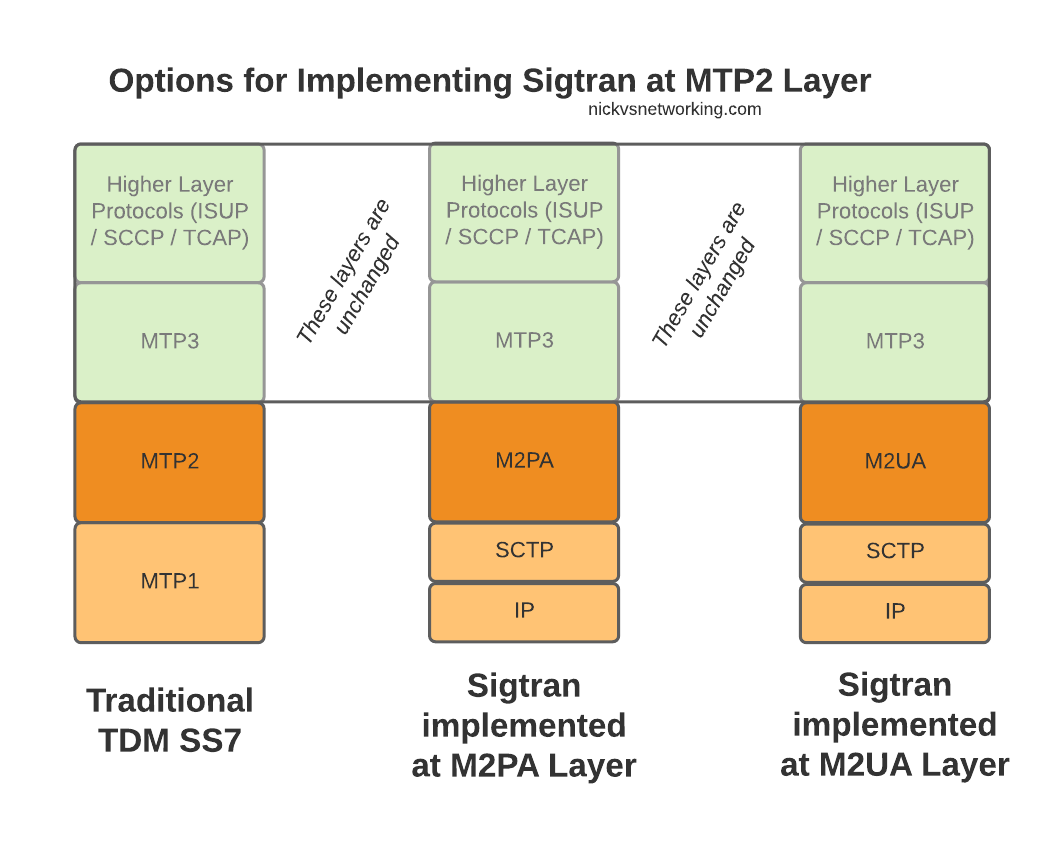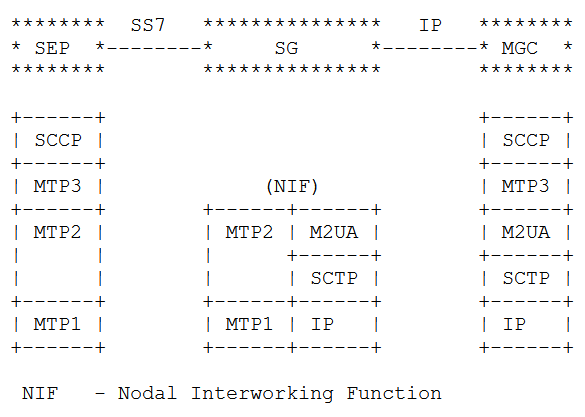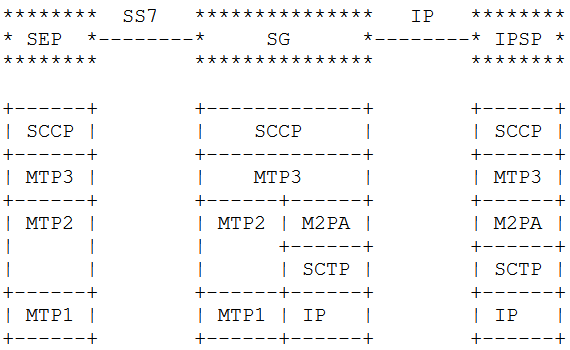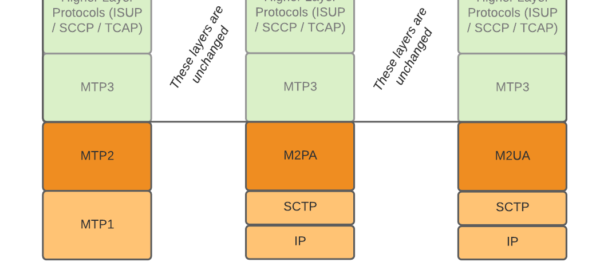This is part of a series of posts looking into SS7 and Sigtran networks. We cover some basic theory and then get into the weeds with GNS3 based labs where we will build real SS7/Sigtran based networks and use them to carry traffic.
So, all going well at this point in the tutorial you’ve got your lab setup with SS7 links between our simulated countries, but we haven’t dug too deep into what’s going on.
Most of the juicy stuff happens in the higher layers, but in this post we’ll look at the Data-Link layer for SS7.
In TDM based SS7 networks, Data Link layer is handled by a layer called “MTP2” – Message Transfer Part 2, which is responsible for flow control and ensuring guaranteed delivery between two points on the network.
MTP2 provides the services you’d typically expect at the Data Link Layer; link alignment, CRC generation/verification, end to end transmission between two points, flow control and sequence verification, etc.
MTP2 is responsible for making the connection between two points capable of carrying those far more interesting upper layers, but it’s really important, particularly when we talk about SIGTRAN/SS7 over IP, to understand how this can be done, so you can understand how the networks fit together.
When we move from TDM based SS7 networks to IP based (Sigtran), MTP2 is removed, and can be replaced with one of two options for transporting Layer 2 messaging over IP, M2UA or M2PA.
All the layers above MTP2 on SS7 or M2UA/M2PA on Sigtran, are unchanged, and the upper layers have no visability that underneath, MTP2 has been replaced with M2UA or M2PA.
Taking MTP2 and putting it onto an IP based Layer 2 protocol is only one option for implementing Sigtran, there are others that we’ll look into as we go along, but with this variant the upper layers above Layer 2 (MTP3) remain changed.

Putting SS7 Data Link Layer (MTP2) onto IP
So the two options – M2UA and M2PA. Why do we have two options?
SS7 networks can be really complicated, and different operators may have different needs when converting these networks to IP.
To satisfy those requirements, there’s a bunch of different flavors of SS7 over IP (Sigtran) available to implement, so operators can select the one that meets their needs and use cases.
This means when we’re learning it, there’s a stack of different options to cover.
On the Layer 2 Level, let’s look at the two options we have in some more detail.
The M2UA Flavour

With a “Nodal Interworking Function” using M2UA, the point codes between our two SS7 nodes remain unchanged.
The SS7 node on the left still talks MTP3 directly with the SS7 node on the right, and the NIF just transparently translates MTP2 into M2UA.
The best analogy I can come up with is that you can think of this as kind of like a Media Converter you’d use for converting between Cat5 to fibre – The devices at each end don’t know they’re not talking over a straight ethernet cable between them, but the media converter changes the transmission medium in between the two in a transparent manner.
M2UA acts in much the same way, except we’re transparently converting the layer 1 & layer 2 signaling, in a way that end devices in the network don’t need to be aware of.
The advantage of this option is that no config changes are needed, we’ve taken our Linksets that were running on TDM and converted them to IP so both ends of the linkset can be moved anywhere with IP connectivity, but transparently to the end devices.
For some carriers this is a real advantage – If you’ve got a dusty SSP running parts of your Customer Access Network, but the engineers who set it up retired long ago and you just want to drop those leased lines, M2UA could be a good option for you.
The disadvantage, as you might have guessed, is that we don’t get much value from just replacing the link from one point to another. It solves one problem, but doesn’t take that much of a step towards converging our network to run over IP.
The M2PA Way
The M2PA way looks a bit different. You’ll notice we’ve got MTP3 on the Signaling Gateway we’re introducing into the network.
This means we need to add a point code between the SS7 node on the left and the SS7 node on the right, where there wasn’t one before, and we will need to update the routing tables on both to know to now route to each other via the point code of our Signaling Gateway rather than directly as the would have before we introduced the Signaling Gateway.

We add another point code and an “active” SS7 device, but now we’ve got a lot more flexibility with what we can do, this no longer needs to be a point-to-point link, but with the introduction of the Signaling Gateway can be point-to-multipoint.
In our lab we setup in GNS3 a few lessons ago, if you take a look at the traffic flowing on these links, you’ll see that it is using M2PA, as we’ve got point codes in between.
Pros and Cons of M2PA and M2UA
So which to chose? Well the answer is (as always) it depends.
If you cannot change any config on the end device (as the person who understood how all this stuff works retired long ago), then M2UA is the answer.
M2UA is just an extension/branch of the MTP2 layer onto IP, it has no understanding / support for the higher-layers of SS7.
M2UA is simpler, it doesn’t require as much understanding, it’s a quick-and-easy “drop-in” replacement for back-hauling SS7 onto IP.
As it’s fairly dumb, M2UA can also allow us to split the load on a high traffic device across two or more SS7 nodes behind it, somewhat like a layer 2 load balancer, but this use case is pretty irrelevant these days.
M2PA on the other hand introduces a new Point Code (Operating on Layer 3 / MTP3) in between the two devices.
This means we introduce a new point code in the path, so have to reconfigure the end devices, but affords us access to a lot of newer features.
We can do all sorts of fancy things like routing of MTP3 messages, on the Signaling Gateway.
This allows us to structure our network in new ways, rather than just doing what we were doing before but over IP.
Summary
When it comes to taking SS7 traffic and putting it onto IP at the Layer 2 level, we looked at the two most common options – M2PA and M2UA, and the pros and cons of each.
In our next post we’ll look at doing away with MTP2 layer entirely when we look at M3UA…

Hello Nick,
I’m just writing to thank you for these posts. You have a very nice and simple way of explaining it. I couldn’t stop reading until I finished. I hope you keep talking about it
Thank you very much for sharing these interesting and simple explanation.
I am waiting to her more from you.